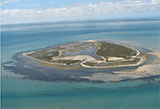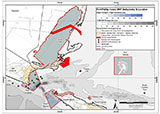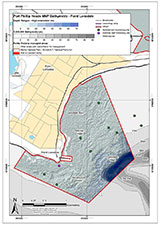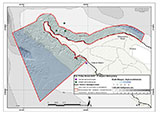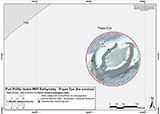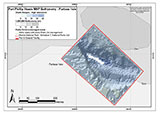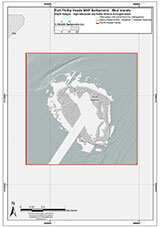Mud Islands
![]() Other |
Other | ![]() Boat access
Boat access
![]()
![]()
![]()
Depth: 1 m (3.28 ft) to 8 m (26 ft)
Go Snorkelling In An Ecologically Invaluable Wetland
Take part in an adventure to one of the most exclusive parts of Port Phillip. The Mud Islands are the largest exposed sandbank in Port Phillip. They are forever changing shape due to storms, tides and sand movement, and are home to a delicate and unique ecosystem.
Snorkelling around the islands and observing animals within the seagrass meadows is an enjoyable pastime. The seagrass meadows and fine muds around the islands are home to a myriad of worms, molluscs and crustaceans that are prey for birds and fish.
The Mud Islands reserve is located within Port Phillip, about 90 km (56 mi) south-west of Melbourne, Australia, lying 10 km (6.21 mi) inside Port Phillip Heads, 7 km (4.35 mi) north of Portsea and 9 km (5.59 mi) east of Queenscliff. The land area of about 50 hectares (120 acres) is made up of three low-lying islands surrounding a shallow tidal 35 hectare (86 acre) lagoon connected to the sea by three narrow channels.
First sighted by Europeans in 1802, the islands were originally named Swan Isles, because of the large number of swans on the surrounding waters. They were also known as Signet Islands and Flat Islands. It was not until 1836 that Lieutenants T M Symonds and H R Henry of HMS Rattlesnake surveyed the islands and renamed them Mud Islands. They were proclaimed a sanctuary for all native game in 1931 after a long history of guano mining.
Marine Life:
Mud Islands consists of shelly sand ridges capped by dunes that enclose a shallow lagoon and salt marshes, which are uncommon and of state geological significance. The dense seagrass habitat in Mud Islands supports at least twenty seven species of finfish and one species of squid. Fish are generally more abundant in the shallow (< 1 m) seagrass beds than in the deeper (2 - 8 m) beds.
The seagrass provides a nursery and breeding area for a range of marine species including King George Whiting, Oysters, Muscles and Scallops. In the shallow seagrass beds the Wide-body Pipefish, Spotted Pipefish, Half-banded Pipefish and Port Phillip Pipefish are found. The Australian Giant Cuttlefish has been found in the deeper seagrass beds along with Red Mullet, Little Gurnard Perch and Yank Flathead.
Many shark species use the Mud Islands area for basking, and Bronze Whaler Sharks use the warm waters around the islands to give birth to their young.
Bird Life:
The low lying Mud Islands vegetation consists of saltmarsh and dune shrubland. This creates an internationally significant shorebird habitat and a birdlife photographers dream. The islands are a RAMSAR international wetland conservation area, with up to 70 species of birds. Mud Islands has the second-largest crested tern nesting colony in Victoria. It is also a major roost site for waders with up to 5000 birds in summer, and it is also used by Australian pelicans. The Mud Islands also provide important breeding habitats for spoonbills, cormorants, silver gulls and terns to name a few, while many long-distance migratory species and a number of endangered species can also be found here.
Bird Life at Mud Islands | Credit: Parks Victoria
While you have the day to explore the island your interests may lie in soaking up some sunshine on the beach or in the shallows, viewing the skyline of Melbourne and the Portsea, Sorrento cliffs while watching the ships navigate the channels.
To hop from island to island you may need to wade through water up to knee-deep, so dress suitably and wear shoes such as wetsuit boots or sandals that can get wet. Bring a day pack with a drink bottle, lunch, hat, sunscreen and a weatherproof jacket and remember your camera and binoculars.
Access:
The Mud Islands can only be reached by boat, the most convenient departure points being Queenscliff or Sorrento. Day visitors are permitted, but overnight camping is not. Visits need careful planning to avoid the boat being stranded at low tide. The Mud Islands are in a 5 knots (9.26 kpm) speed limited boating zone.
Port Phillip Heads Marine National Park
This site lies in the Port Phillip Heads Marine National Park. The park is made up of six separate marine areas around the southern end of Port Phillip: Swan Bay, Mud Islands, Point Lonsdale, Point Nepean, Popes Eye, and Portsea Hole.
Thirty-one of the 120 shipwrecks known to have occurred within a 10 nautical mile radius of Port Phillip Heads are thought to be within the Port Phillip Heads Marine National Park in Point Lonsdale and Point Nepean.
Aboriginal tradition indicates that the Bellarine Peninsula side of the Port Phillip Heads Marine National Park is part of Country of the Wathaurung people, and the Mornington Peninsula side, including Mud Islands, is part of Country of the Boon Wurrung people.
See also, Parks Victoria: Port Phillip Heads Marine National Park,
Park Note: Port Phillip Heads Marine National Park,
Port Phillip Heads Marine National Park - Map,
Divers Guide - Port Phillip Heads Marine National Park,
Port Phillip Heads Marine National Park Identification Booklet, and
Taxonomic Toolkit for the Marine Life of Port Phillip Bay.
You are not permitted to carry a spear gun while snorkelling or scuba diving in Port Phillip Heads Marine National Park.
Traditional Owners — This dive site does not lie in the acknowledged traditional Country of any first peoples of Australia.
Mud Islands Location Map
Latitude: 38° 16.205′ S (38.270083° S / 38° 16′ 12.3″ S)
Longitude: 144° 45.514′ E (144.758567° E / 144° 45′ 30.84″ E)
Datum: WGS84 |
Google Map
Added: 2012-07-22 09:00:00 GMT, Last updated: 2022-03-22 17:24:12 GMT
Source: GPS
Nearest Neighbour: Chinamans Hat, 3,415 m, bearing 235°, SW
Port Phillip Heads Marine National Park.
Depth: 1 to 8 m.
Mean water temp - summer: 20.0°C.
Mean water temp - winter: 11.2°C.
[ Top ]
DISCLAIMER: No claim is made by The Scuba Doctor as to the accuracy of the dive site coordinates listed here. Should anyone decide to use these GPS marks to locate and dive on a site, they do so entirely at their own risk. Always verify against other sources.
The marks come from numerous sources including commercial operators, independent dive clubs, reference works, and active divers. Some are known to be accurate, while others may not be. Some GPS marks may even have come from maps using the AGD66 datum, and thus may need be converted to the WGS84 datum. To distinguish between the possible accuracy of the dive site marks, we've tried to give each mark a source of GPS, Google Earth, or unknown.

